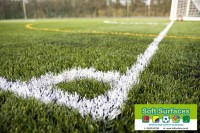The use of artificial grass surfacing for sports pitches and garden lawns has become increasingly popular in the UK over the last few years. Prices for synthetic turf are now more affordable and there is relatively little maintenance involved compared with a natural grass surface as there is no need for mowing, weed killers, watering etc. This increase in installations of artificial grass surfacing means many more people are enjoying high quality and aesthetically beautiful turf surfaces at home and in public sports areas. However there can be some problems with synthetic grass which are sometimes difficult to avoid.
Artificial Turf Disintegration
Even though there are many positive aspects of having artificial turf installed (little maintenance, no mud, use in all weather etc.) and contractors take the best possible care to ensure adequate testing of their products, there are also some limitations involved with synthetic grass surfaces. We have recently found that a number of people have enquired about repairs or resurfacing of their turf lawn or sports pitch because they have been faced with the problem of their synthetic grass melting (yes literally melting). But how can an artificial lawn just disintegrate like that?
Well, the best quality turf is made from a polyethylene material and when sunlight is reflected off a shiny or reflective surface, its heat is concentrated and intensified, if this heat comes into contact with the polyethylene for a sustained period of time it will cause its temperature to increase. If the temperature increases above the melting point of the turf material, the turf will begin to shrink and eventually disintegrate or melt completely. This can occur if sunlight is reflected off surfaces such as doors, windows, polished gutters, mirrors, reflective panels or any other surface which sunlight can bounce off and reflect onto your turf.
Another reason why artificial grass surfacing can melt or disintegrate is through the direct application of heat from something like fire if for example the area has been vandalised, or hot ashes and embers straying from a barbecue or bonfire.

Prevent Synthetic Grass Melting
So now you know how the problem is caused, what can you do to prevent it in the future? There are a number of methods you can utilise and combine to protect your existing synthetic grass surface, or to avoid problems if you’re planning on installing one in the future. If at all possible, it is advised that you tackle any surface which is going to reflect intense heat onto your grass, for example covering windows with a screen or awning, using non-reflective paint on shiny surfaces like gutters and drainpipes or adjusting the angle of any reflective panels or mirrors.
If it is not possible to combat the problems caused by reflective surfacing, for example if it is from another building or house, and the sunlight is only affecting a specific area of the grass, it may be a good idea to find an alternative for that particular patch of surfacing. For example you could install a soil area with a small tree or plants, a pebbled rockery or maybe a pond, this ensures you still keep the beauty of your synthetic grass area but without the damage caused by sunlight.
Synthetic Grass Installers
Soft Surfaces Ltd are experienced contractors in the installation and maintenance of artificial turf lawns and sports surfaces in the UK, if you require repairs or resurfacing to your existing surface, or if you would like a completely new synthetic grass facility, we can help you. If you would like any further information about this or any of our other products, please visit our website at http://sportsandsafetysurfaces.co.uk/ or if you would like to submit an enquiry and discuss quotes, prices and budgets, please email [email protected] and we will be able to give you all the information you need.
If you found this information useful, please share it with your pals and leave us a comment below!
